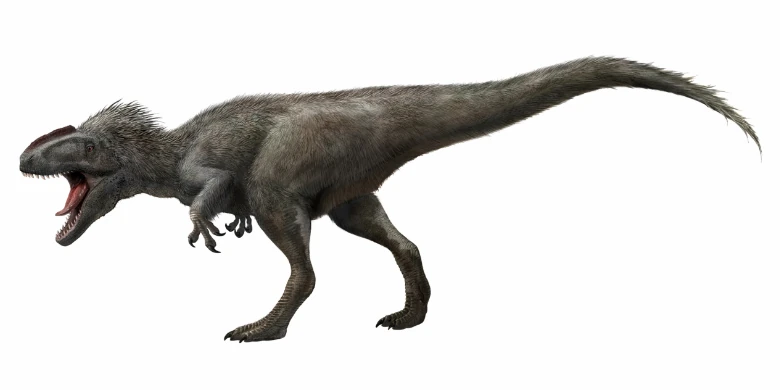 |
| Yue-Yan the Yutyrannus is just one of the creatures Dr. Steve brought back from extinction. |
Dr. Steve is quoted for saying, “We're especially excited to announce the births of three extinct creatures we've brought back to life. This year, we successfully cloned Yue-Yan, a large Chinese predator called the Yutyrannus, Peter, a small parrot-beaked dinosaur called Psittacosaurus and Adeline, an ancient bird called Archaeopteryx.”
I decided to ask Dr. Steve what Yutyrannus actually was. He told me that Yutyrannus was a species of tyrannosaur, a cousin to the larger Tyrannosaurus rex. “I'm particularly glad to add Yutyrannus to our batch of genetically-engineered creatures because it is actually a rather new discovery,” Dr. Steve explains. “It's discovery was only announced in 2012. What also makes Yutyrannus unique is that even though it is a tyrannosaur, it's much more lightweight than T. rex, and has three fingers on relatively long arms rather than the two-fingered tiny arms we're used to seeing on T. rex.” Yutyrannus reaches about 30 feet in length and would have stalked the forests of ancient Cretaceous China, looking for prey. What did it eat? “We haven't found very many large species of herbivores in this region of China,” Dr. Steve explains, “but we do know Yutyrannus co-existed with a host of sauropods and a strange herbivorous dinosaur with sharp claws called Beipiaosaurus.”
Surprisingly, another dinosaur Dr. Steve and his assistants cloned is also from the same region of China: Psittacosaurus. “Psittacosaurus is a small member of the ceratopsian (horned) kind of dinosaur,” Oliver Oviraptor told me. “Ceratopsians were a much more varied group of dinosaurs than most people realize. While Triceratops is the most famous member of the group, with its two large brow horns and smaller nose horn, some ceratopsians have one large horn on the nose and no brow horns like Centrosaurus and Styracosaurus. Others have no nose horn at all, but instead possess cattle-like horns, as seen in Nasutoceratops. Some have a large bump on the end of the nose and not a horn at all, like Pachyrhinosaurus. And finally there are some ceratopsians that lack a horn, have a very small frill, like little sheep-sized Psittacosaurus.” He went on to explain that a feature all ceratopsians share with each other is a parrot-like beak. “Their beaks are rather similar to mine,” Oliver explained. “But while I use mine to scoop up fruits, nuts and small animals (none of whom reside here at Animal Adventures Inc.!), ceratopsians use their beaks to crop vegetation to eat. In fact, Psittacosaurus actually means “parrot lizard”, in reference to its parrot-like beak.”
It is also worth noting that Psittacosaurus is an interesting dinosaur in many other ways. For example, its tail is endowed with a double row of porcupine-like quills. As Peter has demonstrated, his species uses these quills for both display and for defense; upon shaking his tail, Peter can cast out loose quills. This is similar to what modern porcupines can do with their quills. But juts like modern porcupines, Psittacosaurus can't exactly aim and shoot their quills, contrary to popular belief, meaning they tend to fly in all directions...better stay out of the way when Psittacosaurus gets angry!
Dr. Steve said regarding Psittacosaurus that, “I didn't even know we would get the opportunity to clone this dinosaur. See, when Dr. Samuel Adamson came back from China, in addition to the fossils of Yutyrannus, he also found amber containing fossilized biting insects. It turned out that one of those insects was holding Psittacosaurus DNA inside its gut. Of course, we couldn't know what species it had sucked the blood from until we cloned it. Imagine my surprise when we got our first look at the Psittacosaurus. Absolute wonder.”
And finally, Dr. Steve wanted to show me a creature he is particularly proud of – an Archaeopteryx named Adeline. “I haven't been able to clone very many extinct birds,” he explained. “Until last year, the only one we've successfully cloned was Caudipteryx. Adding Archaeopteryx to our collection is a real treat.” Archaeopteryx was a species of perching bird uncovered from the Jurassic rock layers of Germany. When discovered in the 1800's, what made this creature such an incredible find was that Archaeopteryx represents the first fossil skeleton ever found with feathers. “Evolutionists like to use Archaeopteryx as proof that evolution occurred in the past,” Dr. Steve explained. “Proof that dinosaurs evolved into birds; because Archaeopteryx has many reptilian features, including a toothy jaw, clawed wings, a long bony tail and so on. However, these features occur in other extinct or living birds. Plus, Archaeopteryx's DNA, which we analyzed, clearly makes it distinct from dinosaurs.”
The wonders of paleontology, geology and genetics have once again allowed Dr. Steve Stevenson and his lab assistants to bring just a few more creatures back to life. “I hear Dr. Adamson will be going to Africa this summer,” Dr. Steve said. “I can't wait to see what fossils he brings back so that we may bring yet more animals out of extinction.”
Written by: Mr. Smiley
Photographer: Daniel P. Smithwater
Edited by: Christian Ryan
Weekly Cartoon
Next Issue: Let's All Dance Like a Caudipteryx!

No comments:
Post a Comment